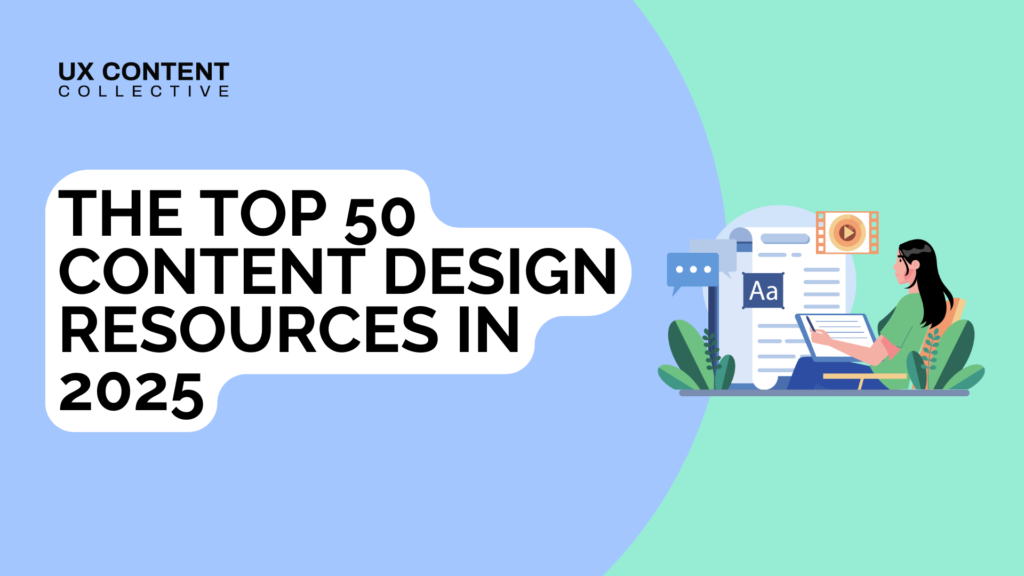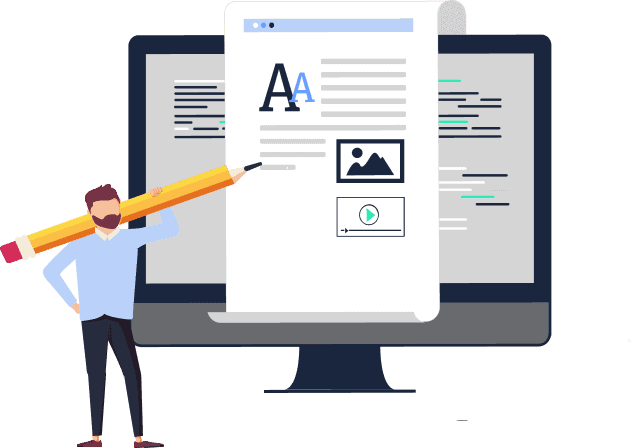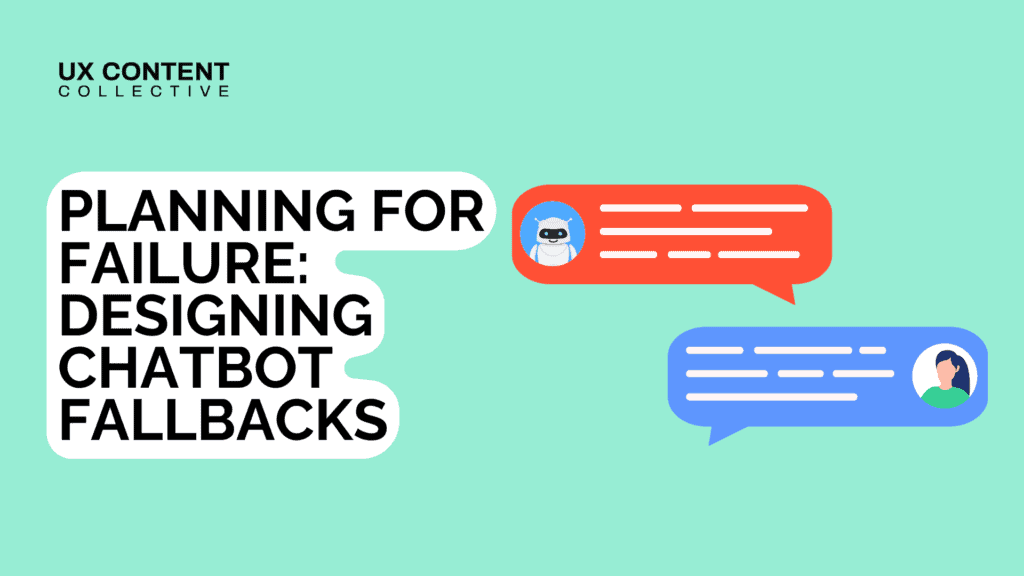

Interested in UX writing and content design?
Explore our content design and UX writing training:

It’s that time of the year. Time to reflect, look back on the biggest trends in our field, and plan accordingly for what’s coming next. We’ve pulled together the links that received the most clicks from our weekly Dash newsletter for you to enjoy in one place. We know you might be thinking, “Another roundup?” Yes, but you’ll want to bookmark this one. Let’s get to it…
1. Best Figma plugins for writers in 2022. So many plugins, so little time. This roundup from Frontitude is definitely worth referencing though. It includes everything from search and navigation plugins to visual support and placeholder plugins to replace Lorem Ipsum for good. Give it a bookmark!
2. When life gives you lemons, write better error messages. How did the team at Wix tackle thousands of error messages in the span of one month? Set aside this post from Jenni Nadler to learn more about the aptly named Errorgate 2021.
3. Figma’s guide to Figma. Wondering which bells and whistles are worth implementing in your content mocks? Figma’s own Ryan Reid compiled a comprehensive overview for UX writers picking up and learning the tool. Get the guide.
4. What job are your words doing? For many users, “just” picking up the phone, or “simply” filling out a form is anything but easy. In this post, Lizzie Cass-Maran shows the nuances of word choice and how we can make our writing clear and friendly—without using any microaggressions.
5. Spotify keeps it personal. In this one, Jasmine Bilham explores how the streaming service uses emotional design to keep listeners (and users) coming back to their product year after year. Read the full blog.
6. Everyone has a type. Content designers come in all shapes, sizes, and creative “types.” Knowing yours will help you maximize your potential. Discover if you’re a Thinker, Maker, Dreamer, and more with this gorgeous quiz designed by Adobe.
7. Your go-to UX glossary. Our field is full of terminology and technical jargon that can be hard to decipher. Pretty ironic, huh? If you need a primer, Tina Golub’s UX glossary is a great place to start.
8. To err is human. To write helpful error messages, divine. Learn how you can go above and beyond the “golden formula” with this useful guide from Kyra Lee, UXCC instructor and Associate UX Writer at UserTesting. The key takeaway? Empathize with users and the people you work with.
9. It’s an experience library. Design systems are great, but the name implies only designers use them. And that’s not the case! Enter: The Experience Library. It’s a place for anyone working on products, services, and comms to go for content guidelines, design principles, and accessibility standards. Explore the Co-op library to get inspired.
10. Anticipation. Context. Empathy. Apple gets to the core (see what we did there?) of designing inclusive interfaces for their products with the P.A.C.E. framework. Revisit the WWDC 2022 session exploring human-centric writing for interfaces through the lens of language.
11. Create a content ecosystem map. Who doesn’t love a good map? Scott Kubie has a great resource collecting a few articles on creating content maps. If you’re confused about the content across your organization, no matter the format, this is a good start to get stuff organized.
12. Inclusive UX writing at HelloFresh. Wondering what this looks like in practice? Emerson Schroeter shares how HelloFresh content designers incorporate inclusive language into their products and train in accessibility as a team. Read the blog post.
13. Content + design = a match made in heaven. We know you know this already, but it’s important to reiterate. Our teams—and ultimately our products—are better when we work together. Jan Rojcek, UX Director at Indeed, shares how their team improved communication and built a framework for effective collaboration. This is a must-read.
14. Systemizing your product copy. If we can rely on design systems for button font, sizing, and colors, shouldn’t the same be the case for the text that goes on the button? Text is a system, after all. Our friends at Ditto explore this idea in their Config talk and recap blog post.
15. The best resources mentioned at Button 2022. Button was a great experience, but there were so many tools, books, resources, and other goodies referenced that it can be hard to keep track. Clare Scott compiled all the resources into a handy list.
16. Content-first design wins. We know that you know content-first design matters or you wouldn’t be reading this. But here we are! This blog post serves as a great reminder—or excuse—to forward to a coworker who doesn’t quite get it yet. Read more from Liam King on the GatherContent blog.
17. Designing for ADHD makes for better experiences. Minimizing distractions and reducing cognitive load benefits all users. I mean, who doesn’t want a more clear, more focused experience? Here’s a great use case on why designing for accessibility actually makes your product better for everyone.
18. Time to put your research hat on. Wondering what makes your users tick? The good people over at User Interviews have compiled a comprehensive guide to user research—covering everything from selecting participants and conducting sessions to analyzing the data and reporting out findings. Bookmark this user research guide.
19. Content designers and technical writers assemble. When UX content design and technical writing teams unite, they access content superpowers. UX Mag explains this synergy.
20. Designing with words. In this one, Rachel McConnell, Torrey Podmajersky, Ben Martin, and Laura Costantino share their POV on how to best integrate content design into a product development lifecycle and how to measure if it’s working or not. See their responses…
21. R-E-S-P-E-C-T. That’s right! All users deserve to be treated well. And it’s about more than just sounding friendly in your microcopy. Nick DiLallo offers up eight ways content designers can focus on a little respect in their content.
22. Stop being so polite. Yes, you read that right. No more “sorry” or “please” in your writing. Why? A lot of that polite language can actually get in the way of a good user experience. Which is pretty impolite, eh? Read more pointers from the Carmax UX team.
23. Five tips for simplifying UX. This one from Maggie Wilson reminds us of a few reliable ways to improve product harmony with words. One quote that stands out: “In the end, though, the complexity of language should be inappreciable.” Read the full post to get inspired.
24. Five steps for building a content design system. As @zeldman so eloquently said, design without content is just “decoration.” In this blog, Jordan Bowman outlines how to set up a content design system using Ditto and Figma.
25. Misfit? This is why you’re great at content. We all have unique perspectives to bring to the content design table. This podcast episode of Content Rookie explores how UX content folks can embrace “counterculture” and their own quirky abilities. Catch the episode with Nicole Michaelis and guest Bill Kurland. Next, read Bill’s take on punk in UX.
26. Microcopy, big value. While effective single-word CTAs look effortless, it actually takes years of practice to master the art of succinct writing and delivering the right message to users at the right time. Make like Picasso and take pride in the utility of all copy, macro and micro. Read more from Hannah McKenzie for Atlassian’s blog.
27. Designing a more effective portfolio. There’s no one-size-fits-all formula for creating a standout portfolio. José Torre shares advice in this post from Shopify UX—and just look at those delightful illustrations.
28. User Inyerface. Alright, this one is completely useless. Well, that’s the point. In this game, you’ll have to see how fast you can fill out a form while running into the worst UX/UI design practices known to humankind. Try out the game…
29. 20 content designers share their daily routines. Although no two days look the same, Megan O’Neill started to uncover interesting trends and insights when interviewing 20 content designers from different organizations—including tools, structure, and process. Read Megan’s post.
30. Know your worth. Feeling left out (or worse, undervalued) by your own colleagues? As a UX writer, there are many ways you can elevate your role, communicate the critical work that you do, and get your whole team on your court. Get the top six effective tips to do just that in this Medium article.
31. You get a request! You get a request! They come in from Slack. Email. Asana. Taps on the shoulder. It’s time to put an end to the content request madness. Over on the Writer blog, check out advice for how the busiest content teams handle internal requests.
32. How to use storytelling in UX. According to Scientific America, 65% of conversation is stories. I mean, who doesn’t love hearing about a relationship’s happy ending or eavesdropping on some juicy gossip? Over on the Smashing Magazine blog, Marli Mesibov shares how we can channel these human instincts to make our products engaging. Read more on the art of storytelling.
33. Get the international inclusive writing guide. If you found the Gender-Inclusive Language Project videos helpful, we’ve got more for you. This time, our project speakers teamed up to put together a tangible guide full of inclusive writing best practices for your team to follow. Get the international guide.
34. Product too complex to explain? Sounds like the perfect job for storytelling. Content designers Jane Palash and Dana Young share how the Shopify UX team brought the Marketplace Kit to life with the help of a clear narrative. Check out the case study.
35. Designing for cognitive accessibility. At Confab earlier this spring, Amy Grace Wells took the stage to advocate for neurodiversity in content design. The team has made the video publicly available, and we’re giving it the signal boost it deserves. Set aside 27+ minutes for this talk.
36. Imagine playing Scrabble without rules. First of all, it would be a complete free-for-all in my house. Second, it wouldn’t make any sense. Alana Fialkoff uses this example to illustrate just how interconnected product and content can (and should) be. Without product design, there’s nothing for our words to shape. Without content design, there’s no cohesive story for our product to tell. Read the full piece to see how we’re stronger together.
37. What do moving and content audits have in common? Only everything. Both require making detailed pre-start lists—what to keep/toss and logistics. Both need a packing strategy, like grouping kitchen items and specific observations together into larger containers. This Shopify blog post furnishes handy takeaways like how to rank the problems you want to solve in order of importance—for any task you’re facing.
38. Perfecting your content design portfolio. To help her break into the content design role of her dreams, India-raised, Italy-based designer Kasturi Roy created an online portfolio from a blank page in 45 days. See the behind-the-scenes breakdown of the process.
39. Time to spill all the tea. Wondering what it’s like to work on a UX writing team for a streaming company like Spotify? Same. Well, wonder no more! Anjana Menon, Fran Catanuso, Nicole Michaelis, and Chris Diken answer some of the most common Qs they get in their DMs. Dive in on the Spotify blog.
40. Think like a PM. If you can’t beat ‘em, join ‘em. Michelle Sargent, Senior Content Strategist at Indeed, outlines ways content designers can adopt a product manager mindset to better prepare and pitch ideas.
41. Does ADHD optimize creativity? The research points to yes. In this piece, Eleanor Turner explores the link between neurodivergence and innovative thinking. We also love that the visuals included throughout were made by four creatives living with ADHD. Read the full post.
42. Resume content we like to see. Considering a career in UX? Make sure to refer to NN/g’s guide to designing the perfect resume, complete with advice including what to include, framing your non-UX work experience, and what to avoid (sorry, headshots are a no-go).
43. UX is ch-ch-changing. Our field has invented and re-invented itself over the years. We’ve moved from sites to apps and other digital products. We’ve moved from Agile to Lean. In this post, Andy Budd argues that “the spirit of UX is around. It’s just not evenly distributed.” Read more about the slow (but inevitable) demise of UX design.
44. Hold the hamburgers, please. No, not your lunch. The design pattern! As we continue to move towards a mobile-first world, it’s essential to consider how our smartphone navigation designs should adapt. Smashing Magazine covers how to create a seamless mobile UX.
45. When product and content team up, customers win. Time for a case study. This one from Ariel van Spronsen shows how a product designer and a content designer collaborated closely to redesign the HubSpot CMS domain connection flow. Success. Check it out on the HubSpot blog.
46. Up for a challenge? Card sorting, journey mapping, usability testing. This collection of UX challenges from UX Tools is as good as gold.
47. You gotta love the process. If you want to work in content design, you’ve got to love all of the research, testing, and iteration that goes into the end product. UXCC’s own Patrick Stafford shares this and other advice for career transitioners with the folks at Working In Content. Read the interview for more pointers.
48. Podcast: Managing design system content. In this episode, Larry Swanson chats with Nicole Michaelis, Senior UX Writer at Spotify, on creating and managing design-system content. Good stuff. Important stuff. Catch the conversation here.
49. The case for storytelling in case studies. In this post, Jamie Wallace shares why (and how) you can reverse engineer an effective case study and approach it like a best-selling author. Taking notes… More over on the Writer blog.
50. Re-designing an industry. Airbnb has flipped the traditional travel booking user flow to incentivize exploration, with a keen focus on delivering the best experience, no matter where. Daniel de Mello unpacks the app’s “biggest change in a decade” and ponders the potential impacts it could have on the travel industry as a whole. Read more on Airbnb’s redesign.




